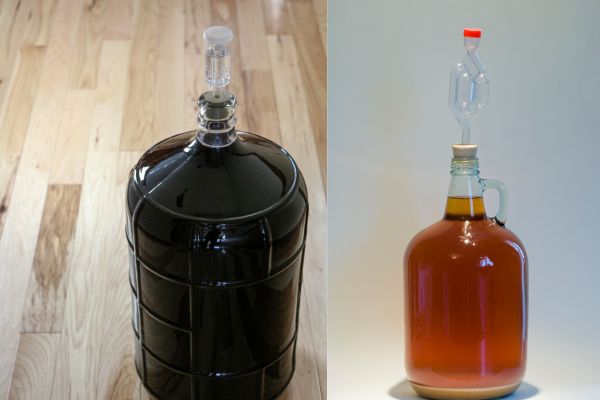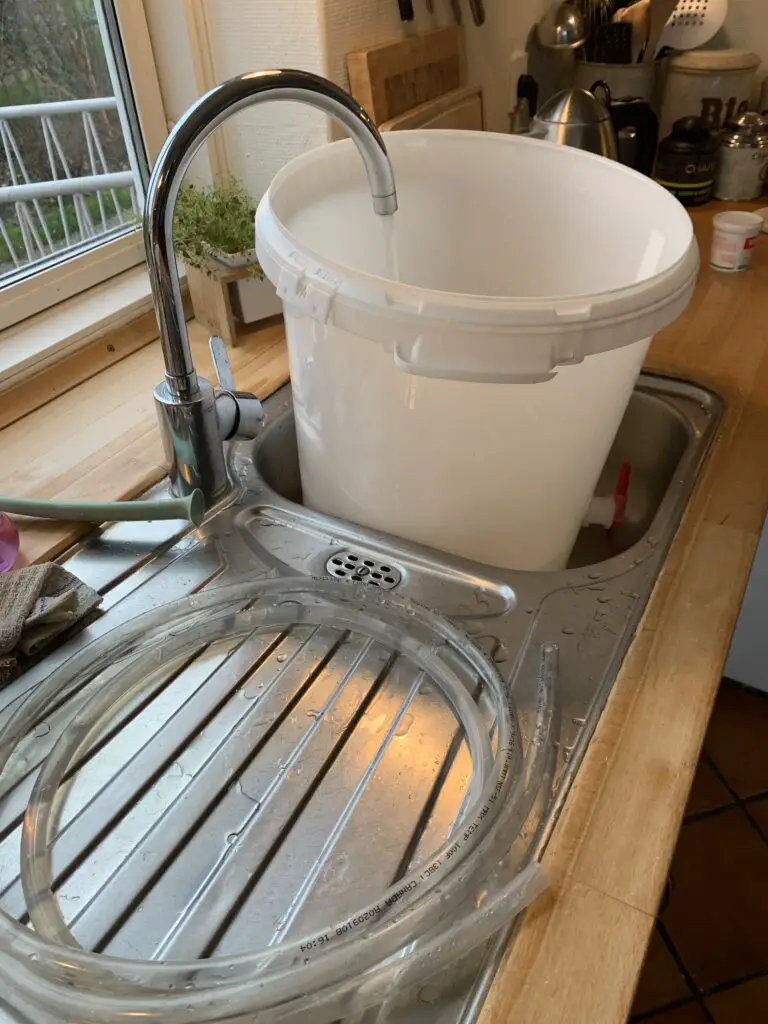You’ve brewed your first batch, and it’s now time to move on to the secondary fermentation process. But the question pops up: is a bucket or carboy better for secondary fermentation?.
In simple terms, both buckets and carboys have their pros and cons. It all depends on your specific brewing needs and preferences. Personally, I prefer carboys for reasons I will discuss below.
In this blog post, we will take a deep dive into the benefits and drawbacks of both options, based on personal experience and industry knowledge.
The Basics of Secondary Fermentation
Secondary fermentation is a crucial step in the beer brewing process. It’s a period of additional fermentation that allows the beer to clear and develop its flavors.

The yeast and other solids will settle at the bottom, leaving you with a clearer and tastier beer. It’s usually carried out in a separate vessel, either a bucket or a carboy.
The Advantages of Carboys in Secondary Fermentation
Carboys, on the other hand, are excellent for long-term aging. They are made of glass or plastic, and these materials are more resistant to scratching than buckets.
The primary reason I prefer carboys over buckets is that they have a more narrow opening that allows less air to come in contact with the brew. This makes carboys a safer option for preventing oxygenation and contamination.

Another advantage of carboys is their transparency. You can keep an eye on the fermentation process and easily notice any issues like mold growth or off-colors.
Also, the narrow neck of a carboy reduces the risk of oxygen exposure every time want to take samples, which can spoil the beer at this late stage in fermentation.
However, carboys have their drawbacks. They are heavier than buckets, making them more challenging to move around.
Also, cleaning a carboy can be a hassle due to its narrow opening. Lastly, carboys can be more expensive than buckets.
The Case for Buckets in Secondary Fermentation
Buckets are a popular choice for secondary fermentation due to their practicality. First off, they are easy to clean and sanitize. You can reach inside a bucket to scrub off any stubborn residue. Buckets are also lightweight, making them easy to move around. Plus, they are generally cheaper than carboys.

The wide opening of a bucket allows for easy addition of flavoring agents or dry hopping. You don’t have to worry about clogging a narrow neck as you would with a carboy. Lastly, buckets are opaque, which keeps out light that could potentially damage the beer.
The main downside to using buckets is that they are prone to scratching. These scratches can harbor bacteria and wild yeast, which can contaminate your beer.
Also, buckets don’t offer the same visual appeal as carboys. You can’t watch the fermentation process happen in real-time.
The Impact of Material on Secondary Fermentation
Whether you choose a bucket or a carboy, the material of your vessel can significantly influence the quality of your beer. Plastic vessels are lighter and cheaper, but they are more prone to scratching. Glass, on the other hand, is scratch-resistant but can be heavy and fragile.
Would I Go with Buckets or Carboys?
In my brewing journey, I have used both buckets and carboys for secondary fermentation. I find buckets more practical for short term secondary fermentation due to their ease of use. And they often have a build-in tap, so you can serve your wine directly (if you do not want carbonation, that is!).
However, for long-term aging and flavor development, I prefer carboys – or barrels for outright aging. They offer a safer environment against contamination and allow for visual monitoring.
Plastic carboys – the ultimate compromise?
While plastic carboys might not possess the same aesthetically pleasing qualities as glass carboys, their practicality, safety, and overall functionality make them an excellent compromise for homebrewers who seek a reliable fermentation vessel.
Whether you’re a novice or experienced brewer, a plastic carboy can be a valuable addition to your brewing equipment.
Let’s explore some of the reasons why plastic carboys may strike an ideal balance:
- Durability: Unlike glass carboys, which can be fragile and prone to breakage, plastic carboys are made from high-quality, food-grade, and impact-resistant materials. This durability makes them less likely to shatter, which can be a safety hazard when dealing with glass carboys.
- Lightweight and Portable: Plastic carboys are significantly lighter than glass carboys, making them easier to handle and transport. This feature is especially useful for homebrewers who need to move their fermenting batches around, as well as those who participate in brewing events or competitions.
- Cost-Effective: When compared to glass carboys, plastic carboys are generally more affordable. This cost-effectiveness is particularly appealing to beginner homebrewers or those on a budget who want to invest in quality fermentation vessels without breaking the bank.
- Transparency: Like glass carboys, plastic carboys can also be transparent, allowing homebrewers to monitor the fermentation process easily. This visibility is crucial for gauging the activity, yeast health, and clarity of the brew during fermentation.
- Fermentation Performance: Plastic carboys are designed with airtight lids and minimal headspace, reducing the risk of oxidation during fermentation. Moreover, they do not allow light to penetrate, which can be beneficial in preventing skunky flavors that can occur with glass carboys exposed to light.
- Easy to Clean: Cleaning plastic carboys is relatively straightforward. They don’t have the same risk of shattering as glass carboys, which means you can be less cautious while scrubbing or handling them. Many plastic carboys also have wide-mouth openings, making cleaning and sanitizing the interior much more accessible.
- Longevity: With proper care, plastic carboys can last for a long time, making them a wise investment for homebrewers looking for a reliable fermentation vessel that will serve them well over multiple brews.
- Secondary Fermenter Capability: Some plastic carboys are designed with a conical shape, which allows for easy racking of the beer and collection of sediment during secondary fermentation. This feature is similar to that of glass carboys, but again, with the added benefit of being lightweight and more durable.
In the grand scheme of things, the choice between a bucket and a carboy for secondary fermentation depends on your brewing needs and preferences.
Buckets are great for their ease of use, cleaning, and affordability. Carboys, on the other hand, offer better protection against contamination, allow for visual monitoring, and are ideal for long-term aging.
In the end, it’s all about finding what works best for you and your brewing style. Happy brewing!
FAQs
Why use glass carboys?
Glass carboys are often preferred for various reasons. Firstly, glass is inert and does not react with the contents, ensuring that the taste, aroma, and quality of the stored liquid remain unaltered. Secondly, glass is impermeable, preventing oxygen or other gases from entering or escaping the carboy, which is crucial for certain processes like fermentation or aging. Additionally, glass carboys are easy to clean and sanitize, and their transparent nature allows for visual monitoring of the contents. They are also durable and can withstand temperature changes, making them suitable for a wide range of applications in brewing, winemaking, or storing other liquids.
Can you do secondary fermentation in a bucket?
Yes, you can perform secondary fermentation in a bucket. A bucket can be a suitable vessel for secondary fermentation, especially if it has an airtight seal. However, it is important to ensure that the bucket is properly sanitized to prevent contamination and to minimize oxygen exposure during fermentation. Additionally, using an airlock or a blow-off tube can help release excess carbon dioxide without allowing oxygen to enter the bucket.
Can I ferment wine in a 5 gallon bucket?
Yes, you can ferment wine in a 5-gallon bucket. However, it is important to ensure that the bucket is made of food-grade material, such as HDPE plastic, to avoid any potential contamination. Additionally, you will need to use an airlock or a fermentation lid to allow carbon dioxide to escape while preventing oxygen or other contaminants from entering the bucket. Proper sanitation and temperature control are also crucial during the fermentation process to ensure a successful outcome.
Can you ferment in a 5 gallon bucket?
Yes, you can ferment in a 5-gallon bucket. 5-gallon buckets are commonly used for home fermentation projects such as brewing beer, making wine, or fermenting vegetables like sauerkraut. However, it’s important to ensure that the bucket is made of food-grade plastic and is properly sanitized before use to prevent any contamination.
Why use a carboy instead of a bucket?
A carboy is often preferred over a bucket for several reasons. Firstly, carboys are typically made of glass or plastic, which provides better oxygen barrier properties compared to a bucket, reducing the risk of oxidation in certain applications like winemaking. Secondly, carboys are more durable and less susceptible to scratches or dents, ensuring a longer lifespan and minimizing the risk of contamination. Additionally, carboys often have a narrower neck, making them easier to handle and reducing the chances of spills or splashing during transfers.
Can I ferment wine in plastic container?
Yes, you can ferment wine in a plastic container. However, it is important to use food-grade plastic that is specifically designed for fermentation. Make sure the container is clean and sanitized before using it, and ensure that it has an airtight seal to prevent oxidation.




